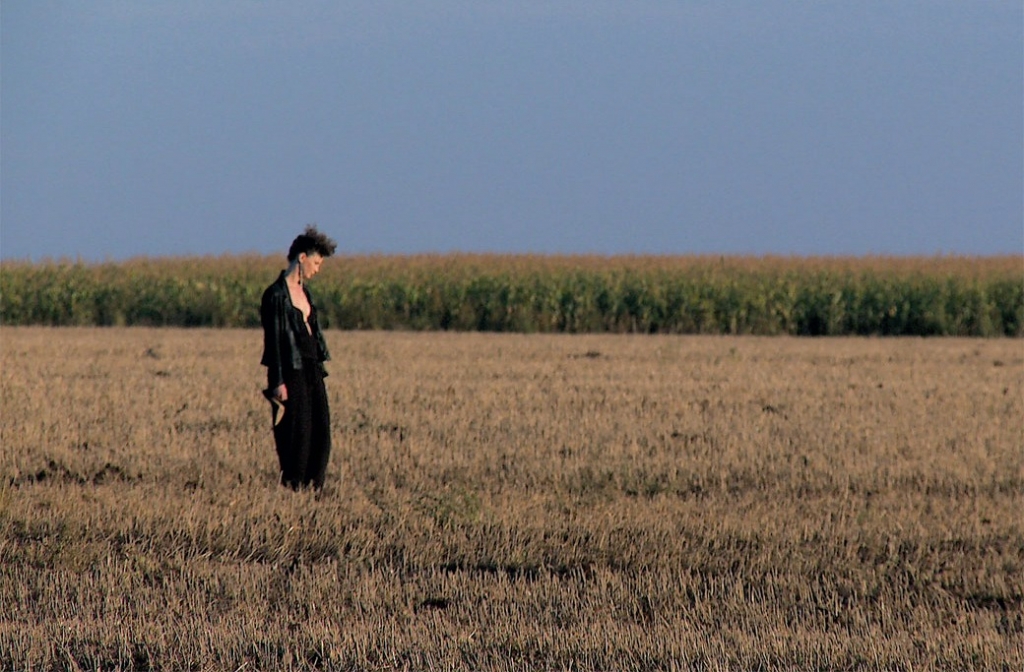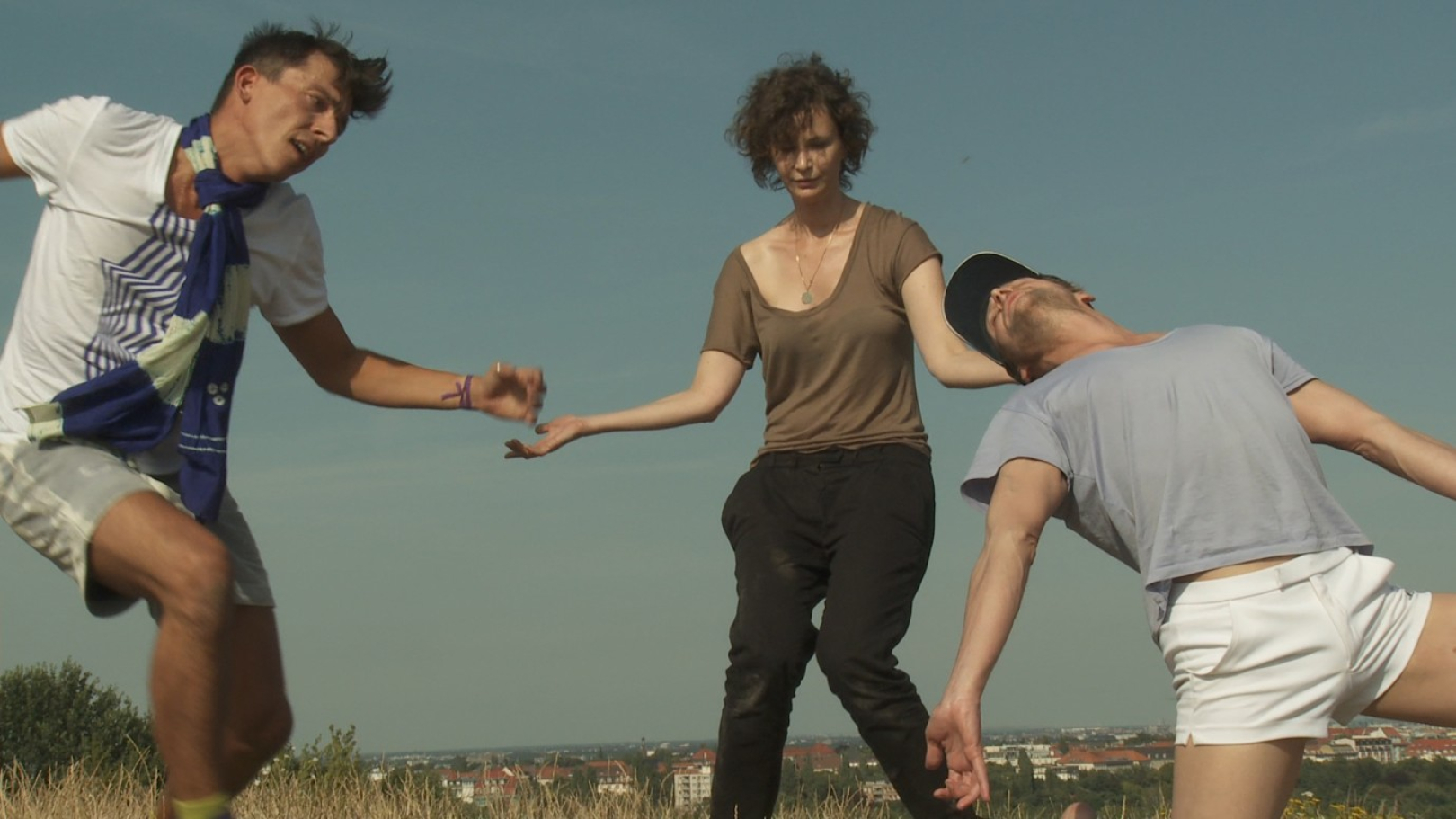Eine flexible Frau

Greta: 40, an architect, mother of a 12-year-old son, separated from her husband, recently unemployed. She starts working in a call center but is soon dismissed once again. She does everything in her power to keep hanging on in there, starts drinking and drifts through the city, torn between the pressure to confirm and the spirit of contradiction.
A Woman Under the Influence, in Berlin at the beginning of the 21st century. The so-called New Berlin, moving from the wastelands to the town houses. Flexible, globalized capitalism. Postfeminism. And the respective vocabulary that goes with it: fragments of theory, empty phrases, buzz words, quotes. A woman with a vision of urban space, of herself, of her profession, of her life with her child. But those aren't the actual circumstances. Greta at parties, at the call center, at sessions with a job application coach, with her son, with her ex-colleagues, at the job center, at bars, walking through the city. Fierce, hysterical, stubborn, almost in a trance, fractious, uninhibited, effusive, desperately unhappy. Situations, encounters, performances. More of a trip than a narrative. Snap-shots of a woman's fragile contemporary life (at work). A flexible woman, an All-Around Reduced Personality.
Birgit Kohler
The city of women
The initial inspiration for my film was Richard Sennett’s book "The Corrosion of Character". Sennett describes the harsh demands for change that postmodern capitalism places on the individual. I wanted to tie this basic fact of current societal developments to the special situation of women and ask about the degree to which the propounded image of the “modern emancipated woman” is nothing more than an affirmation of the current status quo, a “conservative emancipation.”
My heroine confronts the more affirmative figures of women – the city of women. She is a critic and doubter, seeking in vain to adjust to circumstances without giving up her autonomy and dignity. It is made clear to her that this can no longer be done; the price of adjustment would be to abandon her critical stance toward the world.
Part of these clear, unambiguous political statements is the depiction of what one might call the romantic alternative.
The film’s narrative structure is circular. It begins with the ending and ends with the beginning.
Tatjana Turanskyj
“Discourse and cinematic emotion are no contradiction”
At the center of the film are a woman and a city. The film interweaves female biography and urban topography in many ways: it is a women’s Berlin film. Where did you get the idea for this constellation?
At first I wanted to make a film about a woman who drifts through Berlin, tracing the city’s changes. Then I decided on this unemployed architect, a drifter investigating the city’s changes while conducting architectural research in order to “do something.” An important question was how artificial this female character and the film ought to be.
I realized from the beginning that I had to work with the ultra-new image of Berlin. I didn’t want to reproduce Berlin as a backdrop, but to show how Berlin has been tidied up in the last ten years and how much of what characterizes the city – or characterized it, at least for me – has been and is being destroyed and torn down. With my film, I wanted to launch a debate about this destruction, which is pushed by a conservative lobby. It became a Berlin movie in which one does not always recognize Berlin, because in some scenes the city looks like a model. What is ugly has to be shown.
Your film deals prominently with the image of the city, on the basis of current urban theory discourses. How would you describe the importance of Berlin’s architectures (Humboldt Forum, townhouses, Finance Ministry, etc.) for your film?
It’s interesting that you mention the Finance Ministry. It’s an example of how history is treated in Berlin. Significant sites are taken over, renamed, and reoccupied. Other sites, like a castle, are rebuilt; artificial significance is created, but a different palace is torn down. Or take the townhouses on Werderscher Markt. There land is being subdivided like in the 19th century and a kind of TV soap opera backdrop is being built. But these new architectures and buildings are the public space and a wonderful film backdrop, because they represent the spirit of the times.
These architectures are my heroine’s antagonist carved in stone, if you will. And she struggles against them like Don Quixote. So it’s a hopeless battle. But she’s not naïve. She knows that she, too, would immediately build townhouses if she had a job in an architects’ office that happens to build them. That is the dilemma of our present.
In the course of the film, your heroine, the unemployed architect, conducts a tour de force with numerous stations. How did you develop this route, and what was your intent?
From the beginning, I wanted to interweave three levels in my film: first, a narrative level, the story of my heroine Greta; second, a feminist level of commentary, originally connected solely to the Internet blogger “Kluge”; and third, a documentary level. While working on the script and film, I kept struggling to connect the levels meaningfully.
In addition, there was the contradiction between a stringent dramaturgy of decline and a laconic drift through Berlin with “genuine, authentic” chance encounters in the city of women. For example, my fictitious heroine would attend a party convention or an award ceremony from the Association of Female German Entrepreneurs – rather bizarre events.
But fortunately my budget forced me to concentrate, i.e., to first work through the stations that seemed necessary, to be able to adequately localize the heroine’s situation: her social situation, her private situation, and her societal situation as a jobless woman.
But perhaps the fiction of documentation – the idea of “reality” of some kind – is more my thing.
Your film draws a precise picture of the times and society, without working with the conventions of Social Realism. On the contrary, there are actual anti-illusionistic performances. And the characters’ speech and diction is often emphatically inauthentic: empty phrases and quotations whose quotation marks are also spoken, as it were. What led to this decision?
Thanks for the compliment, but I think I draw my personal, subjective idea of an image of the times and society. I notice that more and more people say “one” when they speak of themselves – so they are split off from themselves and their feelings. Also, on the job, the word “unprofessional” is usually used when someone has expressed himself too emotionally. It’s happened to me, too. I wanted to depict that: the norming of language as a “sign of professionalism.”
Film is often reduced to pure content, the story. My film’s story is as simple as can be. A 40-year-old woman loses her job and has problems. Here, the form is interesting.
I’m also interested in the post-dramatic discourse, the explosion of narration, fissures, and counteracting commentary. These are often confused with lack of emotion, but of course that’s wrong. A film can be emotional, despite commentary and self-referentiality. Discourse and cinematic emotion are no contradiction. There are plenty of examples.
What references were important to you while making your film?
Lots of things. I used to make films with a collective. I had to emancipate myself from it, but also had to consider what aspects of our approach to work had proven themselves and should be retained. I also watched many films centered on a leading character. I analyzed how much personality and individuality the other female characters need.
To work out the film images, I cut up my Vogue collection, put a mood book together, and illustrated almost all the scenes with fashion photos. The actresses’ poses, the make-up session, the call-center girls – it’s all from Vogue. For example, there is a series of photos with businesswomen in the desert. It really inspired me. I’m also interested in the Western, or the images the Western produced. The solitude of the hero against the rest of the world. That’s a motif that seems very interesting to me for representing women and is well-suited for reloading for that purpose.
The film collects and comments on various contemporary (self-) designs and types of women. The feminist filmmakers of the 1970s and 1980s delved intensely into the “theme of women’s images.” What led you to work in this terrain again now?
The “theme of women’s images” was, is, and remains important. Today, popular series and films that target a female audience, without being political or feminist at all, appropriate vulgarized feminist themes. I didn’t want my film to serve this kind of images of women in any way. On the contrary, my female characters are not role models. So I take up the tradition of feminist film.
The driving force of the film is the state of acute unemployment and its effects on self-image and self-confidence. How important to you was this sociopolitical dimension of the film?
The situation of so-called modern women in today’s service economy is central to my film. Although women in our society earn about 25 percent less, they are considered the “winners” of the current crisis. Why? Because most of them work as flexible service personnel in low-wage sectors. That’s just cynical! But my leading character comes from a male-dominated profession, a high-wage sector, and is not willing to adjust to this service model, i.e., to function in contemporary society. At the same time, she doesn’t at all question her own dependency on the complex of “work, status, and money.” And precisely this difference interests me. I also wanted to depict how uncertain living and working conditions make biographies “precarious,” which is typical of Berlin and our time.
Your film’s tone of voice is similar to its protagonist: witty, impudent, combative, willful, and extremely sad. In this context, how should we view the excerpt from Hölderlin’s "Hyperion"?
I was looking for a quotation for the last encounter. I just stumbled over Hölderlin; I admit it was coincidence. His language moved me, and the quotation brings a strangeness into the film, a consolation from another era.
Interview: Birgit Kohler, Berlin, January 2010
details
-
Runtime
97 min -
Country
Germany -
Year of Presentation
2010 -
Year of Production
2010 -
Director
Tatjana Turanskyj -
Cast
Mira Partecke, Katharina Bellena, Laura Tonke, Sven Seeger, Torsten Haase, Fabio Pink, Michaela Benn, Ilya Papatheodorou, Thorsten Heidel, Andina Weiler, Angelika Sautter, Anna Schmidt, Ninoschka Schlothauer, Franziska Dick, Bastian Trost, Saskia Draxler, Chunchun Qian, Aizhen Xu, Weihua Wang, Mattis Hausig, Roman Weiler, Horst Markgraf, Sean Patten -
Production Company
Turanskyj & Ahlrichs GbR -
Berlinale Section
Forum -
Berlinale Category
Feature Film
pictures from the movie

Biography Tatjana Turanskyj
Tatjana Turanskyj was born in Hanover on July 27, 1966. She studied literature, theater, and sociology in Frankfurt am Main. Before and during her studies, she acted in productions by Einar Schleef at the Schauspiel Frankfurt and at the Schillertheater Berlin. Tatjana Turanskyj has worked in the field of video, film, and performance since 1998. Eine flexible Frau is her first feature film.